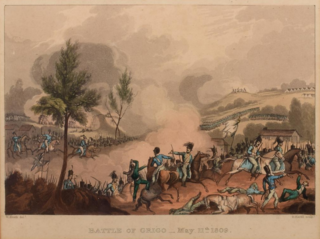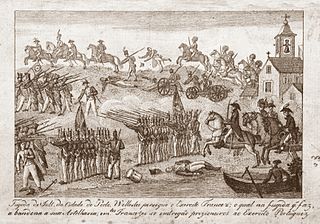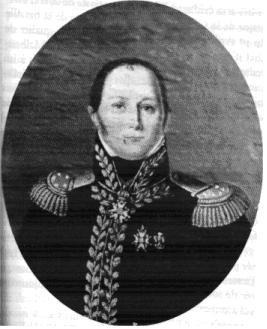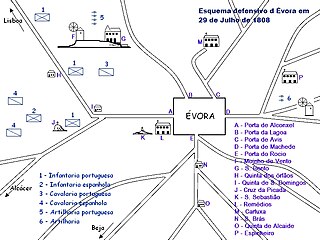
The Battle of Salamanca on 22 July 1812 was a battle in which an Anglo-Portuguese army under the Earl of Wellington defeated Marshal Auguste Marmont's French forces at Arapiles, south of Salamanca, Spain, during the Peninsular War. A Spanish division was also present but took no part in the battle.

At the Battle of Fuentes de Oñoro, the British–Portuguese Army under Wellington checked an attempt by the French Army of Portugal under Marshal André Masséna to relieve the besieged city of Almeida.

At the Battle of Roliça, the first battle fought by the British army during the Peninsular War, an Anglo-Portuguese army under Sir Arthur Wellesley defeated an outnumbered Imperial French division under General of Division Henri François Delaborde, near the village of Roliça in Portugal. The French retired in good order.

The Battle of Talavera was fought just outside the town of Talavera de la Reina, Spain some 120 kilometres (75 mi) southwest of Madrid, during the Peninsular War. At Talavera, a British army under Sir Arthur Wellesley combined with a Spanish army under General Cuesta in operations against French-occupied Madrid. The French army withdrew at night after several of its attacks had been repulsed.

The Battle of Buçaco or Bussaco, fought on 27 September 1810 during the Peninsular War in the Portuguese mountain range of Serra do Buçaco, resulted in the defeat of French forces by Lord Wellington's Anglo-Portuguese Army.

The Battle of Grijó was a battle that ended in victory for the Anglo-Portuguese Army commanded by Lieutenant-General Sir Arthur Wellesley over the French army commanded by Marshal Nicolas Soult during the Second French invasion of Portugal in the Peninsular War. The next day, Wellesley drove Soult from Porto in the Second Battle of Porto.

The Second Battle of Porto, also known as the Battle of the Douro or the Crossing of the Douro, was a battle in which General Arthur Wellesley's Anglo-Portuguese Army defeated Marshal Soult's French troops on 12 May 1809 and took back the city of Porto. After taking command of the British troops in Portugal on 22 April, Wellesley immediately advanced on Porto and made a surprise crossing of the Douro River, approaching Porto where its defences were weak. Soult's late attempts to muster a defence were in vain. The French quickly abandoned the city in a disorderly retreat.

Antoine-François Brenier de Montmorand served as a French general of division during the period of the First French Empire and became an officer of the Legion of Honour.
This is an order of battle for the Battle of Vimeiro that was fought on 20 August 1808.

The Battle of Sabugal was an engagement of the Peninsular War which took place on 3 April 1811 between Anglo-Portuguese forces under Arthur Wellesley and French troops under the command of Marshal André Masséna. It was the last of many skirmishes between Masséna's retreating French forces and those of the Anglo-Portuguese under Wellington, who were pursuing him after the failed 1810 French invasion of Portugal.

Louis Henri Loison briefly joined the French Army in 1787 and after the French Revolution became a junior officer. Blessed with military talent and courage, he rapidly rose to general officer rank during the French Revolutionary Wars. He got into difficulties because of his fondness for plundering. In late 1795 he helped Napoleon Bonaparte crush a revolt against the government. After a hiatus, he returned in 1799 to fight in Switzerland where he earned another promotion. In 1800 he commanded a division under Napoleon in the Marengo campaign.

Eloi Charlemagne Taupin became a French soldier before the French Revolution and was killed in 1814 leading his division in battle against the British and the Spanish in southern France. After fighting in the French Revolutionary Wars, he was promoted to command an infantry regiment at the beginning of the First French Empire. He led the unit during the War of the Third Coalition in 1805. The following year he fought in the War of the Fourth Coalition. The year 1808 found him at Zaragoza in Spain where he was wounded. In 1809 he led a brigade during the War of the Fifth Coalition at Gefrees.
Lieutenant-General Sir Wroth Palmer Acland KCB was an English soldier, notable for his role in the Peninsular War.
Robert Anstruther, was a Scottish general who served during the French Revolutionary and Napoleonic Wars.

Claude François Ferey, Baron de Rozengath was a French division commander during the Napoleonic Wars. At the end of the Battle of Salamanca his division held off the victorious Anglo-Portuguese forces, while the rest of the army escaped. He was killed in this action.

The Battle of Évora saw an Imperial French division under Louis Henri Loison attack a combined Portuguese-Spanish force led by Francisco de Paula Leite de Sousa. Encountering Leite's smaller body of soldiers outside Évora, the French easily brushed them aside and went on to storm the city, which was held by poorly armed townsmen and militia. The French butchered the Portuguese defenders and brutally sacked the town.

The invasion of Portugal saw an Imperial French corps under Jean-Andoche Junot and Spanish military troops invade the Kingdom of Portugal, which was headed by its Prince Regent João of Bragança. The military operation resulted in the occupation of Portugal. The French and Spanish presence was challenged by the Portuguese people and by the United Kingdom in 1808. The invasion marked the start of the Peninsular War, part of the Napoleonic Wars.

The Battle of Alcántara saw an Imperial French division led by Marshal Claude Perrin Victor attack a Portuguese detachment under Colonel William Mayne. After a three hours skirmish, the French stormed across the Alcántara Bridge and forced the Portuguese to retreat. The clash happened during the Peninsular War, part of the Napoleonic Wars. Alcántara, Spain is situated on the Tagus river near the Portuguese border, 285 kilometres (177 mi) west-southwest of Madrid.

Pierre Margaron led the French cavalry at the Battle of Vimeiro in 1808. He joined a volunteer battalion in 1792. He rose in rank during the French Revolutionary Wars until he commanded a heavy cavalry regiment in 1798. He led his horsemen at the Trebbia, Novi and Genola in 1799 and Pozzolo and San Massimo in 1800. He became a general of brigade in 1803 and led a corps light cavalry brigade at Austerlitz, Jena and Lübeck. He participated in the 1807 invasion of Portugal and fought at Évora and Vimeiro. From 1810 to 1812 he held a post in the interior. He became a general of division in 1813 and led troops at the Battle of Leipzig. His surname is one of the names inscribed under the Arc de Triomphe, on Column 2.
Barnard Foord Bowes or Barnard Bowes Foord commanded a British brigade in several battles during the Peninsular War. He joined the 26th Foot Regiment as a junior officer in 1781 and rose in rank by purchase to become lieutenant colonel of the 6th Foot Regiment in 1796. He led troops during the Irish Rebellion of 1798. From 1799 to 1806 he served in Canada and married his wife there. He led a brigade at Roliça and Vimeiro in 1808. He was promoted major general in 1810. He was severely wounded while leading his brigade in an assault during the 1812 Siege of Badajoz. He was killed in action leading a storming column at the Siege of the Salamanca Forts.


















